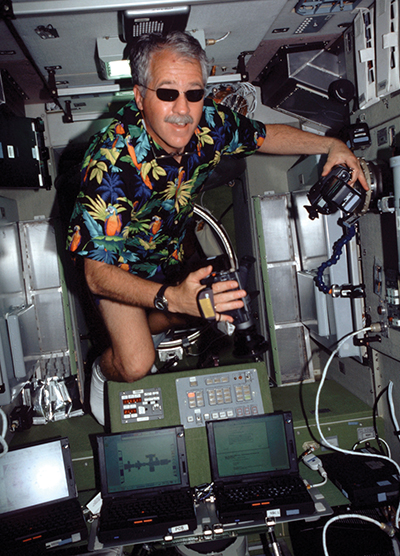Space-Age Shades
Since 1989, Dr. Keith Manuel has been recognized as the "official" optometrist overseeing the NASA Space Shuttle, the International Space Station, and various other vision-related space projects. In 1990, Dr. Manuel was selected by NASA's Johnson Space Center to perform studies establishing the viability of contact lenses in space flight. Ever since this initial research effort, he has continued to provide vision care for the astronaut corps, while finding time to co-author the ophthalmic chapter in the book, "Principles of Clinical Medicine for Space Flight."
Dr. Manuel's contribution to the Space Program does not stop there, however. He and a company renowned for its stylish eyewear products are responsible for bringing a titanium alloy frame to NASA that can withstand the extreme conditions of space travel. After rigorous testing by NASA scientists, the Agency agreed that the Titan Minimal Art frame was best suited to protect the eyes of astronauts on their space missions.
The frame, produced by Silhouette International Schmied AG (Silhouette), is extremely light in weight and devoid of hinge screws, which reduces the danger potential for astronauts to a minimum. Because astronauts work in sensitive environments, tiny screws or eyeglass components that become loose or fall off could lead to a catastrophe. Such hazards could potentially come in to play during Extra Vehicular Activity (EVA), when astronauts spacewalk with only the protection of their spacesuits. A loose screw or component during an EVA could be nasally or orally ingested, causing choking; could be drawn into the coolant system impeller, causing mechanical suit failure; or could cause a tear in the suit bladder, resulting in a loss of suit pressure.
The already difficult-to-handle conditions of space are further exacerbated by the fact that astronauts can be on the job for up to 10 hours without pause, while wearing tight-fitting helmets. Long durations in spacesuits preclude astronauts from using their hands in the event that their eyeglasses slip out of place.
Silhouette's Titan Minimal Art frames possess a super elasticity that ensures a slip-free fit for wearing comfort, without causing irritating pressure points. The titanium alloy used in the frames also prevents allergic reactions. This technology is available to both NASA astronauts and public consumers in either corrective eyewear or sunglass models.
The only difference between the sunwear used by NASA astronauts and the commercial models is the lens. Dr. Manuel and Silhouette brought NASA a lens that is considerably darker (5.5-percent overall light transmittance), with a thin gold coating that offers total protection, not only against ultraviolet (UV) radiation, but also against the harmful infrared radiation in space.
Silhouette adapted the NASA lens to offer commercial users lasting comfort and protection against harmful infrared light exposure. The company's Voyager™ lens uses the combination of a soft-brown tint and a scratch-resistant, bi-layer mirror to strike an ideal balance between the amount of short-wave blue light absorbed and allowed to reach the eye (like UV, blue light has been shown to cause irreversible damage to the eye). These features not only provide contrast enhancement and comfort from the fatigue of scattered blue light, but longer-term wearability and better color perception than many high-contrast lenses.
Silhouette International Schmied AG is based in Linz, Austria, with a U.S. office, Silhouette Optical Ltd., in Northvale, New Jersey.
Voyager™ is a trademark of Silhouette International Schmied AG.

The sunglass lenses worn by NASA astronauts are considerably darker than the commercial lenses, with a thin gold coating that offers total protection, not only against ultraviolet radiation, but also against the harmful infrared radiation in space.













